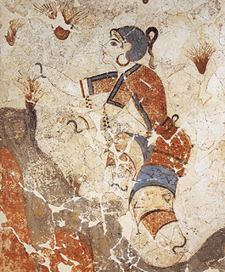Minoan civilization
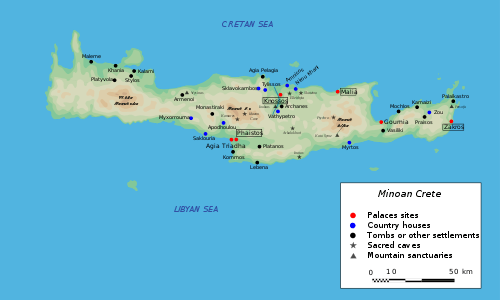 | |
| Period | Bronze Age Europe |
|---|---|
| Dates | c. 2700 – c. 1100 BC |
| Major sites | Knossos, Phaistos, Malia, Zakros |
| Preceded by | Cycladic culture |
| Followed by | Mycenaean Greece |
| Bronze Age |
| ↑ Chalcolithic |
|
Near East (c. 3300–1200 BC) South Asia (c. 3300–1200 BC) Europe (c. 3200–600 BC)
East Asia (c. 2000–300 BC) |
| ↓Iron Age |
|
The Minoan civilization was an Aegean Bronze Age civilization on the island of Crete and other Aegean Islands which flourished from about 2700 to 1600 BC, before a late period of decline, finally ending around 1100 BC. It preceded and was absorbed by the Mycenaean civilization of ancient Greece.[1] The civilization was rediscovered at the beginning of the 20th century through the work of British archaeologist Arthur Evans. The name "Minoan" derives from the mythical King Minos and was coined by Evans, who identified the site at Knossos with the labyrinth and the Minotaur. The Minoan civilization has been described as the earliest of its kind in Europe,[2] with historian Will Durant calling the Minoans "the first link in the European chain".[3]
The Minoan civilization is particularly notable for its large and elaborate palaces, some of which were up to four stories high and featured elaborate plumbing systems and were decorated with frescoes. The most notable Minoan palace is that of Knossos, followed by that of Phaistos. The Minoan period saw extensive trade between Crete, Aegean and Mediterranean settlements, particularly the Near East. Through their traders and artists, the Minoans' cultural influence reached beyond Crete to the Cyclades, the Old Kingdom of Egypt, copper-bearing Cyprus, Canaan and the Levantine coast and Anatolia. Some of the best Minoan art is preserved in the city of Akrotiri on the island of Santorini, which was destroyed by the Minoan eruption.
The Minoans primarily wrote in the undeciphered Linear A, encoding a language hypothetically labelled Minoan. The reasons for the slow decline of the Minoan civilization, beginning around 1550 BC, are unclear; theories include Mycenaean invasions from mainland Greece and the major volcanic eruption of Santorini.
Etymology
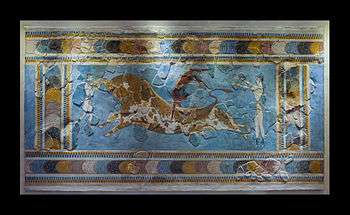
The term "Minoan" refers to the mythical King Minos of Knossos. Its origin is debated, but it is commonly attributed to archeologist Arthur Evans (1851–1941).[4] Minos was associated in Greek mythology with the labyrinth, which Evans identified with the site at Knossos.
However, Karl Hoeck had already used the title Das Minoische Kreta in 1825 for volume two of his Kreta; this appears to be the first known use of the word "Minoan" to mean "ancient Cretan".
Evans probably read Hoeck's book, and continued using the term in his writings and findings:[5] "To this early civilization of Crete as a whole I have proposed—and the suggestion has been generally adopted by the archaeologists of this and other countries—to apply the name 'Minoan'."[6] Evans said that he applied it, not invented it.
Hoeck, with no idea that the archaeological Crete had existed, had in mind the Crete of mythology. Although Evans' 1931 claim that the term was "unminted" before he used it was called a "brazen suggestion" by Karadimas and Momigliano,[5] he coined its archaeological meaning.
Chronology and history
| 3500–2900 BC[7] | EMI | Prepalatial |
| 2900–2300 BC | EMII | |
| 2300–2100 BC | EMIII | |
| 2100–1900 BC | MMIA | |
| 1900–1800 BC | MMIB | Protopalatial (Old Palace Period) |
| 1800–1750 BC | MMIIA | |
| 1750-1700 BC | MMIIB | Neopalatial (New Palace Period) |
| 1700–1650 BC | MMIIIA | |
| 1650–1600 BC | MMIIIB | |
| 1600–1500 BC | LMIA | |
| 1500–1450 BC | LMIB | Postpalatial (at Knossos; Final Palace Period) |
| 1450–1400 BC | LMII | |
| 1400–1350 BC | LMIIIA | |
| 1350–1100 BC | LMIIIB |
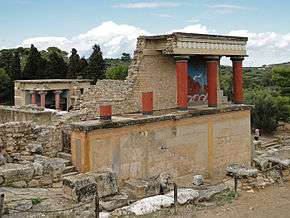
Instead of dating the Minoan period, archaeologists use two systems of relative chronology. The first, created by Evans and modified by later archaeologists, is based on pottery styles and imported Egyptian artifacts (which can be correlated with the chronology of Ancient Egypt). Evans' system divides the Minoan period into three major eras: early (EM), middle (MM) and late (LM). These eras are subdivided—for example, Early Minoan I, II and III (EMI, EMII, EMIII).
Another dating system, proposed by Greek archaeologist Nicolas Platon, is based on the development of architectural complexes known as "palaces" at Knossos, Phaistos, Malia and Kato Zakros. Platon divides the Minoan period into pre-, proto-, neo- and post-palatial sub-periods. The relationship between the systems in the table includes approximate calendar dates from Warren and Hankey (1989).
The Thera eruption occurred during a mature phase of the LM IA period. Efforts to establish the volcanic eruption's date have been controversial. Radiocarbon dating has indicated a date in the late 17th century BC;[8][9] this conflicts with estimates by archaeologists, who synchronize the eruption with conventional Egyptian chronology for a date of 1525–1500 BC.[10][11][12]
Overview
Although stone-tool evidence exists that hominins may have reached Crete as early as 130,000 years ago, evidence for the first anatomically-modern human presence dates to 10,000–12,000 YBP.[13][14] The oldest evidence of modern human habitation on Crete are pre-ceramic Neolithic farming-community remains which date to about 7000 BC.[15] A comparative study of DNA haplogroups of modern Cretan men showed that a male founder group, from Anatolia or the Levant, is shared with the Greeks.[16] The Neolithic population lived in open villages. Fishermen's huts were found on the shores, and the fertile Mesara Plain was used for agriculture.[17]
Early Minoan
The Early Bronze Age (3500 to 2100 BC) has been described as indicating a "promise of greatness"[18] in light of later developments on the island. The Bronze Age began on Crete around 3200 BC,[19] In the late third millennium BC, several locations on the island developed into centers of commerce and handiwork; this enabled the upper classes to exercise leadership and expand their influence. It is likely that the original hierarchies of the local elites were replaced by monarchies, a precondition for the palaces.[20]
Middle Minoan
At the end of the MMII period (1700 BC) there was a large disturbance on Crete—probably an earthquake, but possibly an invasion from Anatolia.[21] The palaces at Knossos, Phaistos, Malia and Kato Zakros were destroyed.
At the beginning of the neopalatial period the population increased again,[22] the palaces were rebuilt on a larger scale and new settlements were built across the island. This period (the 17th and 16th centuries BC, MM III-Neopalatial) was the apex of Minoan civilization. After around 1700 BC, material culture on the Greek mainland reached a new high due to Minoan influence.[20]
Late Minoan
Another natural catastrophe occurred around 1600 BC, possibly an eruption of the Thera volcano. The Minoans rebuilt the palaces with several major differences in function.[23][20][24]
Around 1450 BC, Minoan culture reached a turning point due to a natural catastrophe (possibly an earthquake). Although another eruption of the Thera volcano has been linked to this downfall, its dating and implications are disputed. Several important palaces, in locations such as Malia, Tylissos, Phaistos and Agia Triada, and the living quarters of Knossos were destroyed. The palace in Knossos seems to have remained largely intact, resulting in its dynasty's ability to spread its influence over large parts of Crete until it was overrun by the Mycenaean Greeks.[20]
After about a century of partial recovery, most Cretan cities and palaces declined during the 13th century BC (LHIIIB-LMIIIB). The last Linear A archives date to LMIIIA, contemporary with LHIIIA. Knossos remained an administrative center until 1200 BC. The last Minoan site was the defensive mountain site of Karfi, a refuge which had vestiges of Minoan civilization nearly into the Iron Age.[25]
Foreign influence
The influence of Minoan civilization is seen in Minoan handicrafts on the Greek mainland. The shaft graves of Mycenae had several Cretan imports (such as a bull's-head rhyton), which suggests a prominent role for Minoan symbolism. Connections between Egypt and Crete are prominent; Minoan ceramics are found in Egyptian cities, and the Minoans imported items (particularly papyrus) and architectural and artistic ideas from Egypt. Egyptian hieroglyphs might even have been models for Minoan pictographic writing, from which the Linear A and Linear B writing systems developed.[17] Archaeologist Hermann Bengtson has also found a Minoan influence in Canaanite artifacts.
Minoan palace sites were occupied by the Mycenaeans (who adapted Linear A Minoan script for their own language) around 1420–1375 BC.[26][20] Their language, a form of Greek, was written in Linear B. The Mycenaeans tended to adapt (rather than supplant) Minoan culture, religion and art,[27] continuing the Minoan economic system and bureaucracy.[20]
During LMIIIA (1400–1350 BC), Amenhotep III noted k-f-t-w (Kaftor) as one of the "Secret Lands of the North of Asia" at Kom el-Hatan.[28] Also mentioned are Cretan cities (such as Amnisos, Phaistos, Kydonia and Knossos) and toponyms reconstructed as in the Cyclades or the Greek mainland. If the values of these Egyptian names are accurate, the pharaoh did not value LMIII Knossos more than other states in the region.[29]
Geography
Crete is a mountainous island with natural harbors. There are signs of earthquake damage at many Minoan sites, and clear signs of land uplifting and submersion of coastal sites due to tectonic processes along its coast.[30]
According to Homer, Crete had 90 cities.[31] Judging by the palace sites, the island was probably divided into at least eight political units at the height of the Minoan period. The vast majority of Minoan sites are found in central and eastern Crete, with few in the western part of the island. There are appear to be four major palaces on the island: Knossos, Phaistos, Malia, and Kato Zakros. The north is thought to have been governed from Knossos, the south from Phaistos, the central-eastern region from Malia, the eastern tip from Kato Zakros. Smaller palaces have been found elsewhere on the island.
Major Settlements
- Knossos – the largest[32] Bronze Age archaeological site on Crete. Knossos had an estimated population of 1,300 to 2,000 in 2500 BC, 18,000 in 2000 BC, 20,000 to 100,000 in 1600 BC and 30,000 in 1360 BC.[33][34]
- Phaistos – the second-largest[32] palatial building on the island, excavated by the Italian school shortly after Knossos
- Malia – the subject of French excavations, a palatial center which provides a look into the proto-palatial period
- Kato Zakros – sea-side palatial site excavated by Greek archaeologists in the far east of the island, also known as "Zakro" in archaeological literature
- Galatas – confirmed as a palatial site during the early 1990s
- Agia Triada – administrative center near Phaistos which has yielded the largest number of Linear A tablets.
- Gournia – town site excavated in the first quarter of the 20th century
- Pyrgos – early Minoan site in southern Crete
- Vasiliki – early eastern Minoan site which gives its name to distinctive ceramic ware
- Fournou Korfi – southern site
- Pseira – island town with ritual sites
- Mount Juktas – the greatest Minoan peak sanctuary, associated with the palace of Knossos[35]
- Arkalochori – site of the Arkalochori Axe
- Karfi – refuge site, one of the last Minoan sites
- Akrotiri – settlement on the island of Santorini (Thera), near the site of the Thera Eruption
- Zominthos – mountainous city in the northern foothills of Mount Ida
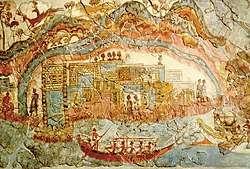
Beyond Crete
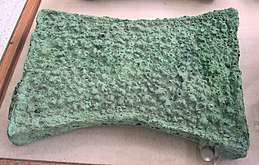
The Minoans were traders, and their cultural contacts reached Egypt's Old Kingdom, copper-containing Cyprus, Canaan and the Levantine coast and Anatolia. In late 2009 Minoan-style frescoes and other artifacts were discovered during excavations of the Canaanite palace at Tel Kabri, Israel, leading archaeologists to conclude that the Minoan influence was the strongest on the Canaanite city-state. These are the only Minoan artifacts which have been found in Israel.[36]
Minoan techniques and ceramic styles had varying degrees of influence on Helladic Greece. Along with Santorini, Minoan settlements are found[37] at Kastri on Cythera, an island near the Greek mainland influenced by the Minoans from the mid-third millennium BC (EMII) to its Mycenaean occupation in the 13th century.[38][39][40] Minoan strata replaced a mainland-derived early Bronze Age culture, the earliest Minoan settlement outside Crete.[41]
The Cyclades were in the Minoan cultural orbit and, closer to Crete, the islands of Karpathos, Saria and Kasos also contained middle-Bronze Age (MMI-II) Minoan colonies or settlements of Minoan traders. Most were abandoned in LMI, but Karpathos recovered and continued its Minoan culture until the end of the Bronze Age.[42] Other supposed Minoan colonies, such as that hypothesized by Adolf Furtwängler on Aegina, were later dismissed by scholars.[43] However, there was a Minoan colony at Ialysos on Rhodes.[44]
Minoan cultural influence indicates an orbit extending through the Cyclades to Egypt and Cyprus. Fifteenth-century BC paintings in Thebes, Egypt depict Minoan-appearing individuals bearing gifts. Inscriptions describing them as coming from keftiu ("islands in the middle of the sea") may refer to gift-bringing merchants or officials from Crete.[45]
Some locations on Crete indicate that the Minoans were an "outward-looking" society.[46] The neo-palatial site of Kato Zakros is located within 100 meters of the modern shoreline in a bay. Its large number of workshops and wealth of site materials indicate a possible entrepôt for trade. Such activities are seen in artistic representations of the sea, including the "Flotilla" fresco in room five of the West House at Akrotiri.
Agriculture and cuisine
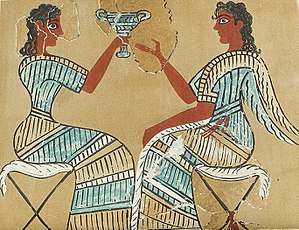

The Minoans raised cattle, sheep, pigs and goats, and grew wheat, barley, vetch and chickpeas. They also cultivated grapes, figs and olives, grew poppies for seed and perhaps opium. The Minoans also domesticated bees.[47]
Vegetables, including lettuce, celery, asparagus and carrots, grew wild on Crete. Pear, quince, and olive trees were also native. Date palm trees and cats (for hunting) were imported from Egypt.[48] The Minoans adopted pomegranates from the Near East, but not lemons and oranges.
They may have practiced polyculture,[49] and their varied, healthy diet resulted in a population increase. Polyculture theoretically maintains soil fertility and protects against losses due to crop failure. Linear B tablets indicate the importance of orchards (figs, olives and grapes) in processing crops for "secondary products".[50] Olive oil in Cretan or Mediterranean cuisine is comparable to butter in northern European cuisine.[51] The process of fermenting wine from grapes was probably a factor of the "Palace" economies; wine would have been a trade commodity and an item of domestic consumption.[52] Farmers used wooden plows, bound with leather to wooden handles and pulled by pairs of donkeys or oxen.
Seafood was also important in Cretan cuisine. The prevalence of edible molluscs in site material[53] and artistic representations of marine fish and animals (including the distinctive LM IIIC "Octopus" stirrup jar), indicate appreciation and occasional use of fish by the economy. However, scholars believe that these resources were not as significant as grain, olives and animal produce. "Fishing was one of the major activities...but there is as yet no evidence for the way in which they organized their fishing."[54] An intensification of agricultural activity is indicated by the construction of terraces and dams at Pseira in the Late Minoan period.
Cretan cuisine included wild game: Cretans ate wild deer, wild boar and meat from livestock. Wild game is now extinct on Crete.[55] A matter of controversy is whereas Minoans made use of the indigenous Cretan megafauna, which are typically thought to have been extinct considerably earlier at 10,000 BC. This is in part due to the presence of dwarf elephants in contemporary Egyptian art.[56]
Not all plants and flora were purely functional, and arts depict scenes of lily-gathering in green spaces. The fresco known as the Sacred Grove at Knossos depicts women facing left, flanked by trees. Some scholars have suggested that it is a harvest festival or ceremony to honor the fertility of the soil. Artistic depictions of farming scenes also appear on the Second Palace Period "Harvester Vase" (an egg-shaped rhyton) on which 27 men led by another carry hoes. This demonstrates the importance of farming as an artistic motif.
The discovery of storage areas in the palace compounds has prompted debate. At the second "palace" at Phaistos, rooms on the west side of the structure have been identified as a storage area. Jars, jugs and vessels have been recovered in the area, indicating the complex's possible role as a re-distribution center for agricultural produce. At larger sites such as Knossos, there is evidence of craft specialization (workshops). The palace at Kato Zakro indicates that workshops were integrated into palace structure. The Minoan palatial system may have developed through economic intensification, where an agricultural surplus could support a population of administrators, craftsmen and religious practitioners. The number of sleeping rooms in the palaces indicates that they could have supported a sizable population which was removed from manual labor.
Tools
Tools, originally made of wood or bone, were bound to handles with leather straps. During the Bronze Age, they were made of bronze with wooden handles. Due to its round hole, the tool head would spin on the handle. The Minoans developed oval-shaped holes in their tools to fit oval-shaped handles, which prevented spinning.[47] Tools included double adzes, double- and single-bladed axes, axe-adzes, sickles and chisels.
Society and culture
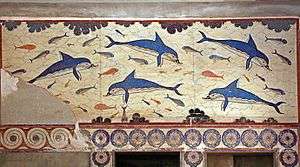
The Minoans were primarily a mercantile people who engaged in overseas trade. After 1700 BC, their culture indicates a high degree of organization. Minoan-manufactured goods suggest a network of trade with mainland Greece (notably Mycenae), Cyprus, Syria, Anatolia, Egypt, Mesopotamia and westward as far as the Iberian peninsula. Minoan religion apparently focused on female deities, with women officiants.[57] While historians and archaeologists have long been skeptical of an outright matriarchy, the predominance of female figures in authoritative roles over male ones seems to indicate that Minoan society was matriarchal, and among the most well-supported examples known.[58]
Government
Because their language has yet to be deciphered, it is unknown what kind of government was practiced by the Minoans, though the palaces and throne rooms indicate a form of hierarchy.
Saffron trade
A fresco of saffron-gatherers at Santorini is well-known. The Minoan trade in saffron, the stigma of a naturally-mutated crocus which originated in the Aegean basin, has left few material remains. According to Evans, the saffron (a sizable Minoan industry) was used for dye.[59] Other archaeologists emphasize durable trade items: ceramics, copper, tin, gold and silver.[59] The saffron may have had a religious significance.[60] The saffron trade, which predated Minoan civilization, was comparable in value to that of frankincense or black pepper.
Fashion
Minoan men wore loincloths and kilts. Women wore robes with short sleeves and layered, flounced skirts. The robes were open to the navel, exposing their breasts.[61] Women could also wear a strapless, fitted bodice, and clothing patterns had symmetrical, geometric designs.
Language and writing
Several writing systems dating from the Minoan period been have unearthed in Crete, the majority of which are currently undeciphered.
The most well-known script is Linear A, dated to between 2500 BC and 1450 BC.[62] Linear A is the parent of the related Linear B script, which encodes the earliest known form of Greek.[63] Several attempts to translate Linear A have been made, but consensus is lacking and Linear A is currently considered undeciphered. The language encoded by Linear A is tentatively dubbed "Minoan". When the values of the symbols in Linear B are used in Linear A, they produce unintelligible words, and would make Minoan unrelated to any other known language.
Linear A is preceded by about century by the Cretan hieroglyphs. It is unknown whether the language is Minoan, and its origin is debated. Although the hieroglyphs are often associated with the Egyptians, they also indicate a relationship to Mesopotamian writings.[64] They came into use about a century before Linear A, and were used at the same time as Linear A (18th century BC; MM II). The hieroglyphs disappeared during the 17th century BC (MM III).
The Phaistos Disc features a unique pictorial script. Although its origin is debated, it is now widely believed to be of Cretan origin. Because it is the only find of its kind, the script on the Phaistos disc remains undeciphered.
In addition to the above, five inscriptions dated to the 7th and 6th centuries BC have been found in Eastern Crete (and possible as late as the 3rd century BC) written in an archaic Greek alphabet that encode a clearly non-Greek language, dubbed "Eteocretan" (lit. "True Cretan"). Given the small number of inscriptions, the language remains little-known. Eteocretan inscriptions are separated from Linear A by about a millennium, and it is thus unknown if Eteocretan represents a descendant of the Minoan language.
Religion
The Minoans seem to have prominently worshiped a Great Goddess, which had previously led to the belief that their society was matriarchal. However it is now known that this was not the case; the Minoan pantheon featured many deities, among which a young, spear-wielding male god is also prominent.[65] Some scholars see in the Minoan Goddess a female divine solar figure.[66][67] Although some depictions of women may be images of worshipers and priestesses officiating at religious ceremonies (as opposed to deities), goddesses seem to include a mother goddess of fertility, a goddess of animals and female protectors of cities, the household, the harvest and the underworld. They are often represented by serpents, birds, poppies or an animal on the head.
According to Nanno Marinatos, "The hierarchy and relationship of gods within the pantheon is difficult to decode from the images alone."[68] Marinatos disagrees with earlier descriptions of Minoan religion as primitive, saying that it "was the religion of a sophisticated and urbanized palatial culture with a complex social hierarchy. It was not dominated by fertility any more than any religion of the past or present has been, and it addressed gender identity, rites of passage, and death. It is reasonable to assume that both the organization and the rituals, even the mythology, resembled the religions of Near Eastern palatial civilizations."[68] It even seems that the later Greek pantheon would synthesize the Minoan female deity and Hittite goddess from the Near East.[69]
Symbolism
Minoan horn-topped altars, which Arthur Evans called Horns of Consecration, are represented in seal impressions and have been found as far afield as Cyprus. Minoan sacred symbols include the bull (and its horns of consecration), the labrys (double-headed axe), the pillar, the serpent, the sun-disc and the tree.
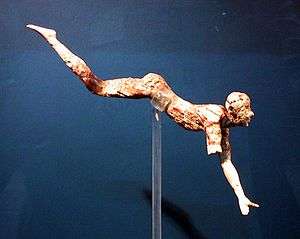
Haralampos V. Harissis and Anastasios V. Harissis posit a different interpretation of these symbols, saying that they were based on apiculture rather than religion.[70] A major festival was exemplified in bull-leaping, represented in the frescoes of Knossos[71] and inscribed in miniature seals.[72]
Burial practices
Similar to other Bronze Age archaeological finds, burial remains constitute much of the material and archaeological evidence for the period. By the end of the Second Palace Period, Minoan burial was dominated by two forms: circular tombs (tholoi) in southern Crete and house tombs in the north and the east. However, much Minoan mortuary practice does not conform to this pattern. Burial was more popular than cremation.[73] Individual burial was the rule, except for the Chrysolakkos complex in Malia. Here, a number of buildings form a complex in the center of Mallia's burial area and may have been the focus for burial rituals or a crypt for a notable family. Evidence of possible human sacrifice by the Minoans has been found at three sites: at Anemospilia, in a MMII building near Mt. Juktas considered a temple; an EMII sanctuary complex at Fournou Korifi in south-central Crete, and in an LMIB building known as the North House in Knossos.
Architecture
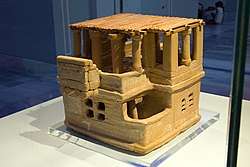
Minoan cities were connected by roads paved with blocks cut with bronze saws. Streets were drained, and water and sewage facilities were available to the upper class through clay pipes.[74]
Minoan buildings often had flat, tiled roofs; plaster, wood or flagstone floors, and stood two to three stories high. Lower walls were typically constructed of stone and rubble, and the upper walls of mudbrick. Ceiling timbers held up the roofs.
Construction materials for villas and palaces varied, and included sandstone, gypsum and limestone. Building techniques also varied, with some palaces using ashlar masonry and others roughly-hewn, megalithic blocks.
Palaces
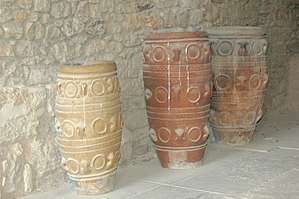

Palaces (anaktora) are the best-known Minoan building types excavated on Crete. They are monumental buildings with administrative purposes, as evidenced by large archives unearthed by archaeologists. Each palace excavated to date has unique features, but they also share aspects which set them apart from other structures. Palaces are often multi-story, with interior and exterior staircases, lightwells, massive columns, storage areas and courtyards.
The first palaces were constructed at the end of the Early Minoan period in the third millennium BC at Malia. Although it was formerly believed that the foundation of the first palaces was synchronous and dated to the Middle Minoan period (around 2000 BC, the date of the first palace at Knossos), scholars now think that the palaces were built over a longer period in response to local developments. The main older palaces are Knossos, Malia and Phaistos. Elements of the Middle Minoan palaces (at Knossos, Phaistos and Malia, for example) have precedents in Early Minoan construction styles.[75] These include an indented western court and special treatment of the western façade. One example is the House on the Hill at Vasiliki, dated to the Early Minoan II period.[76] The palaces were centers of government, administrative offices, shrines, workshops and storage spaces.[77][78]
The Middle Minoan palaces are characteristically aligned with their surrounding topography. The MM palace of Phaistos appears to align with Mount Ida and Knossos is aligned with Mount Juktas,[79] both on a north-south axis. Scholars suggest that the alignment was related to the mountains' ritual significance; a number of peak sanctuaries (spaces for public ritual) have been excavated, including one at Petsofas. These sites have yielded clusters of clay figurines and evidence of animal sacrifice.
Late palaces are characterized by multi-story buildings with west facades of sandstone ashlar masonry; Knossos is the best-known example. Other building conventions included storage areas, north-south orientation, a pillar room and a western court. Architecture during the First Palace Period is identified by a square-within-a-square style; Second Palace Period construction has more internal divisions and corridors.[80] The Palace of Knossos was the largest Minoan palace. The palace is about 150 meters across and it spreads over an area of some 20,000 square meters, with its original upper levels possibly having a thousand chambers. The palace is connected to the mythological story of The Bull of Minos, since it is in this palace where it was written that the labyrinth existed. Focusing on the architectural aspects of the Palace of Knossos, it was a combination of foundations that depended on the aspects of its walls for the dimensions of the rooms, staircases, porticos, and chambers. The palace was designed in such a fashion that the structure was laid out to surround the central court of the Minoans. Aesthetically speaking, the pillars along with the stone paved northern entrance gave the palace a look and feel that was unique to the Palace of Knossos. The space surrounding the court was covered with rooms and hallways, some of which were stacked on top of the lower levels of the palace being linked through multiple ramps and staircases.[81] Others were built into a hill, as described by the site's excavator Arthur John Evans, "...The palace of Knossos is the most extensive and occupies several hills."[82] On the east side of the court there was a grand staircase passing through the many levels of the palace, added for the royal residents. On the west side of the court, the throne room, a modest room with a ceiling some two meters high,[33] can be found along with the frescoes that were decorating the walls of the hallways and storage rooms.
Plumbing
During the Minoan Era extensive waterways were built in order to protect the growing population. These system had two primary functions, first providing and distributing water, and secondly relocating sewage and stormwater.[83] One of the defining aspects of the Minoan Era was the architectural feats of their waste management. The Minoans used technologies such as wells, cisterns, and aqueducts to manage their water supplies. Structural aspects of their buildings even played a part. Flat roofs and plentiful open courtyards were used for collecting water to be stored in cisterns.[84] Significantly, the Minoans had water treatment devices. One such device seems to have been a porous clay pipe through which water was allowed to flow until clean.
Columns
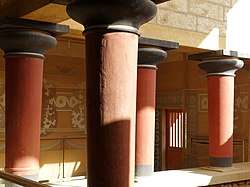
One of the most notable Minoan contributions to architecture is their inverted column, wider at the top than the base (unlike most Greek columns, which are wider at the bottom to give an impression of height). The columns were made of wood (not stone) and were generally painted red. Mounted on a simple stone base, they were topped with a pillow-like, round capital.[85][86]
Villas
A number of compounds known as "villas" have been excavated on Crete. These structures share features of neopalatial palaces: a conspicuous western facade, storage facilities and a three-part Minoan Hall.[87] These features may indicate a similar role or that the structures were artistic imitations, suggesting that their occupants were familiar with palatial culture. The villas were often richly decorated, as evidenced by the frescos of Haghia Triadha Villa A.
Art
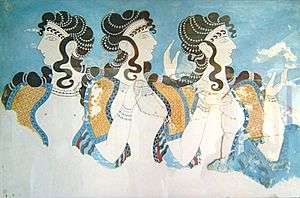
The largest collection of Minoan art is in the museum at Heraklion, near Knossos, on the northern coast of Crete. Minoan art and other remnants of material culture, especially the sequence of ceramic styles, have been used by archaeologists to define the three phases of Minoan culture (EM, MM, LM).
Since wood and textiles have decomposed, the best-preserved (and most instructive) surviving examples of Minoan art are its pottery, palace architecture (with frescos which include landscapes), stone carvings and intricately-carved seal stones.
Frescoes were the primary art form of Minoan culture. They include many depictions of people, with sexes distinguished by color; the men's skin is reddish-brown, and the women's white.[88] Several frescoes at Knossos and Santorini survive. In contrast to Egyptian frescoes, Crete had true frescoes. Probably the most famous fresco is the bull-leaping fresco.[89]
Pottery

A variety of wares were produced in Crete. Early Minoan ceramics were characterized by patterns of spirals, triangles, curved lines, crosses, fish bones, and beak-spouts. During the Middle Minoan period, naturalistic designs (such as fish, squid, birds and lilies) were common. In the Late Minoan period, flowers and animals were still characteristic but more variety existed.
The palace style of the region around Knossos is characterized by geometric simplicity and monochromatic painting. Late Minoan art resembles that of Mycenae. Minoan knowledge of the sea was continued by the Mycenaeans in their frequent use of marine forms as artistic motifs. The so-called "marine style", perhaps inspired by frescoes, has the entire surface of a pot covered with sea creatures, octopus, fish and dolphins, against a background of rocks, seaweed and sponges.
Jewelry
The Minoans created elaborate metalwork with imported gold and copper.[90] Bead necklaces, bracelets and hair ornaments appear in the frescoes,[91] and many labrys pins survive. The Minoans apparently mastered faience and granulation, as indicated by a gold bee pendant. Minoan metalworking included intense, precise temperature, to bond gold to itself without burning it.
Metal vessels

Metal vessels were produced in Crete from at least as early as EM II (c. 2500) in the Prepalatial period through to LM IA (c. 1450) in the Postpalatial period and perhaps as late as LM IIIB/C (c. 1200),[92] although it is likely that many of the vessels from these later periods were heirlooms from earlier periods.[93] The earliest were probably made exclusively from precious metals, but from the Protopalatial period (MM IB – MM IIA) they were also produced in arsenical bronze and, subsequently, tin bronze.[94] The archaeological record suggests that mostly cup-type forms were created in precious metals,[95] but the corpus of bronze vessels was diverse, including cauldrons, pans, hydrias, bowls, pitchers, basins, cups, ladles and lamps.[96] The Minoan metal vessel tradition influenced that of the Mycenaean culture on mainland Greece, and they are often regarded as the same tradition.[97] Many precious metal vessels found on mainland Greece exhibit Minoan characteristics, and it is thought that these were either imported from Crete or made on the mainland by Minoan metalsmiths working for Mycenaean patrons or by Mycenaean smiths who had trained under Minoan masters.[98]
Warfare and the "Minoan peace"
According to Arthur Evans, a "Minoan peace" (Pax Minoica) existed; there was little internal armed conflict in Minoan Crete until the Mycenaean period.[99] However, it is difficult to draw hard-and-fast conclusions from the evidence[100] and Evans' idealistic view has been questioned.[101]
No evidence has been found of a Minoan army or the Minoan domination of peoples beyond Crete, and few signs of warfare appear in Minoan art: "Although a few archaeologists see war scenes in a few pieces of Minoan art, others interpret even these scenes as festivals, sacred dance, or sports events" (Studebaker, 2004, p. 27). Although armed warriors are depicted as stabbed in the throat with swords, the violence may be part of a ritual or blood sport.
On mainland Greece during the shaft-grave era at Mycenae, there is little evidence for major Mycenaean fortifications; the citadels follow the destruction of nearly all neopalatial Cretan sites. Warfare by other contemporaries of the ancient Minoans, such as the Egyptians and the Hittites, is well-documented.
Skepticism and weaponry
Despite finding ruined watchtowers and fortification walls,[102] Evans said that there was little evidence of ancient Minoan fortifications. According to Stylianos Alexiou (in Kretologia 8), a number of sites (especially early and middle Minoan sites such as Aghia Photia) are built on hilltops or otherwise fortified. Lucia Nixon wrote, "We may have been over-influenced by the lack of what we might think of as solid fortifications to assess the archaeological evidence properly. As in so many other instances, we may not have been looking for evidence in the right places, and therefore we may not end with a correct assessment of the Minoans and their ability to avoid war."[103]
Chester Starr said in "Minoan Flower Lovers" (Hagg-Marinatos, eds. Minoan Thalassocracy) that since Shang China and the Maya had unfortified centers and engaged in frontier struggles, a lack of fortifications alone does not prove that the Minoans were a peaceful civilization unparalleled in history. In 1998, when Minoan archaeologists met in a Belgian conference to discuss the possibility that the Pax Minoica was outdated, evidence of Minoan war was still scanty. According to Jan Driessen, the Minoans frequently depicted "weapons" in their art in a ritual context:
The construction of fortified sites is often assumed to reflect a threat of warfare, but such fortified centres were multifunctional; they were also often the embodiment or material expression of the central places of the territories at the same time as being monuments glorifying and merging leading power.[104]
Stella Chryssoulaki's work on small outposts (or guardhouses) in eastern Crete indicates a possible defensive system; type A (high-quality) Minoan swords were found in the palaces of Mallia and Zarkos (see Sanders, AJA 65, 67, Hoeckmann, JRGZM 27, or Rehak and Younger, AJA 102). Keith Branigan estimated that 95 percent of Minoan "weapons" had hafting (hilts or handles) which would have prevented their use as such.[105] However, tests of replicas indicated that the weapons could cut flesh down to the bone (and score the bone's surface) without damaging the weapons themselves.[106] According to Paul Rehak, Minoan figure-eight shields could not have been used for fighting or hunting, since they were too cumbersome.[107] Although Cheryl Floyd concluded that Minoan "weapons" were tools used for mundane tasks such as meat processing,[108] Middle Minoan "rapiers nearly three feet in length" have been found.[109]
About Minoan warfare, Branigan concluded:
The quantity of weaponry, the impressive fortifications, and the aggressive looking long-boats all suggested an era of intensified hostilities. But on closer inspection there are grounds for thinking that all three key elements are bound up as much with status statements, display, and fashion as with aggression;... Warfare such as there was in the southern Aegean early Bronze Age was either personalized and perhaps ritualized (in Crete) or small-scale, intermittent and essentially an economic activity (in the Cyclades and the Argolid/Attica).[110]
Archaeologist Olga Krzyszkowska agreed: "The stark fact is that for the prehistoric Aegean we have no direct evidence for war and warfare per se."[111]
Collapse
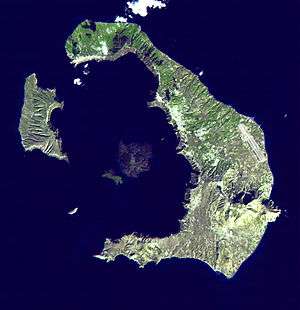
Between 1935 and 1939, Greek archaeologist Spyridon Marinatos posited the Minoan eruption theory. An eruption on the island of Thera (present-day Santorini), about 100 kilometres (62 mi) from Crete, occurred during the LM IA period (1550 - 1500 BC). One of the largest volcanic explosions in recorded history, it ejected about 60 to 100 cubic kilometres (14 to 24 cu mi) of material and was measured at 7 on the Volcanic Explosivity Index.[112][113][114] The eruption devastated the nearby Minoan settlement at Akrotiri on Santorini, which was entombed in a layer of pumice.[115] Although it is believed to have severely affected the Minoan culture of Crete, the extent of its effects has been debated. Early theories proposed that volcanic ash from Thera choked off plant life on the eastern half of Crete, starving the local population;[116] however, more-thorough field examinations have determined that no more than 5 millimetres (0.20 in) of ash fell anywhere on Crete.[117] Based on archaeological evidence, studies indicate that a massive tsunami generated by the Thera eruption devastated the coast of Crete and destroyed many Minoan settlements.[118][119][120] Although the LM IIIA (late Minoan) period is characterized by affluence (wealthy tombs, burials and art) and ubiquitous Knossian ceramic styles,[121] by LM IIIB Knossos' wealth and importance as a regional center apparently declined.
Significant remains have been found above the late Minoan I-era Thera ash layer, implying that the Thera eruption did not cause the immediate collapse of Minoan civilization.[122] The Minoans were a sea power, however, and the Thera eruption probably caused significant economic hardship. Whether this was enough to trigger a Minoan downfall is debated. Mycenaean Greece conquered the Minoans during the late Minoan II period, and Mycenaean weaponry has been found in burials on Crete soon after the eruption.[123]
Many archaeologists believe that the eruption triggered a crisis, making the Minoans vulnerable to conquest by the Mycenaeans.[118] According to Sinclair Hood, the Minoans were most likely conquered by an invading force. Although the civilization's collapse was aided by the Thera eruption, its ultimate end came from conquest. Archaeological evidence suggests that the island was destroyed by fire, with the palace at Knossos receiving less damage than other sites on Crete. Since natural disasters are not selective, the uneven destruction was probably caused by invaders who would have seen the usefulness of preserving a palace like Knossos for their own use.[124] Several authors have noted evidence that Minoan civilization had exceeded its environmental carrying capacity, with archaeological recovery at Knossos indicating deforestation in the region near the civilization's later stages.[125][126]
Genetic studies
Several genetic studies of Bronze Age Cretan Y-chromosomal and mitochondrial DNA (mtDNA) have been conducted, yielding varying results, supporting European, Anatolian, or both Middle Eastern and European origins.[127]
A 2007 Y-chromosomal study found significant difference in the frequencies of haplogroup J2 and haplogroup R1 between regions of the island, with R1 lineages predominant in the Lasithi Plateau and haplogroup J2 lineages predominant in lowland areas. The R1a1 lineages from the Lasithi Plateau showed similarities to Balkan lineages, but not with R1a1 from lowland eastern Crete. The R1b lineages displayed more resemblance to those from Northeast Italy than to those from Turkey and the Balkans.[128]
A 2008 Y-chromosomal study showed that Cretan samples have similarities with central/Mediterranean Anatolia, with high frequencies of J2a-M410 and a low frequency of J2b-M12. The authors also identify two distinctive haplogroups, J2a1h-M319 and J2a1b1-M92, which suggests Bronze Age expansions in Crete from western Anatolia and the Levant, while the presence of haplgroup E-V13 showed a mainland, Mycenaean, contribution.[129]
A 2008 study found that the ancient Minoan mtDNA haplotypes exhibited both Middle Eastern and southeastern European maternal genetic lineages.[130]
A 2013 study compared skeletal mtDNA from ancient Minoan skeletons that were sealed in a cave in the Lasithi Plateau between 3,700 and 4,400 years ago, to 135 samples from Greece, Anatolia, western and northern Europe, North Africa and Egypt.[131][132] The researchers found that the Minoan skeletons were genetically very similar to modern-day Europeans — and especially close to modern-day Cretans, particularly those from the Lasithi Plateau. They were also genetically similar to Neolithic Europeans, but distinct from Egyptian or Libyan populations.[133] "We now know that the founders of the first advanced European civilization were European," said study co-author George Stamatoyannopoulos, a human geneticist at the University of Washington. "They were very similar to Neolithic Europeans and very similar to present day-Cretans."[132]
A 2017 study of mtDNA polymorphisms from Minoan remains published in the journal Nature concluded that the Minoans were genetically closely related with the Mycenaean Greeks, and that both are closely related, but not identical, to modern Greek populations. The same study also stated that at least three-quarters of DNA of both the Minoans and the Myceneans came from the first Neolithic-era farmers that lived in Western Anatolia and the Aegean Sea.[134] [135].
See also
| Wikimedia Commons has media related to Minoan civilization. |
| Library resources about Minoan Civilization |
Notes
- ↑ "Ancient Crete – Classics – Oxford Bibliographies".
- ↑ Sakoulas, Thomas. "History of Minoan Crete".
- ↑ Durant, Will (1939). "The Life of Greece". The Story of Civilization. II. New York: Simon & Schuster. p. 21. ISBN 9781451647587.
- ↑ John Bennet, "Minoan civilization", Oxford Classical Dictionary, 3rd ed., p. 985.
- 1 2 Karadimas, Nektarios; Momigliano, Nicoletta (2004). "On the Term 'Minoan' before Evans's Work in Crete (1894)" (PDF). Studi Micenei ed Egeo-anatolici. 46 (2): 243–258.
- ↑ Evans 1921, p. 1.
- ↑ This chronology of Minoan Crete is (with minor simplifications) the one used by Andonis Vasilakis in his book on Minoan Crete, published by Adam Editions in 2000, but other chronologies will vary, sometimes quite considerably (EM periods especially). Sets of different dates from other authors are set out at Minoan chronology. The adjustments made were: Source: "Early Minoan III, Middle Minoan IA 2300-1900 BCE", "Middle Minoan IIB, IIIA 1750-1650 BCE" - in both cases the run-together periods have been split equally.
- ↑ Manning, Sturt W; Ramsey, CB; Kutschera, W; Higham, T; Kromer, B; Steier, P; Wild, EM (2006). "Chronology for the Aegean Late Bronze Age 1700–1400 BC". Science. 312 (5773): 565–569. Bibcode:2006Sci...312..565M. doi:10.1126/science.1125682. PMID 16645092. Retrieved 2007-03-10.
- ↑ Friedrich, Walter L; Kromer, B; Friedrich, M; Heinemeier, J; Pfeiffer, T; Talamo, S (2006). "Santorini Eruption Radiocarbon Dated to 1627–1600 B.C". Science. 312 (5773): 548. doi:10.1126/science.1125087. PMID 16645088. Retrieved 2007-03-10.
- ↑ "Chronology". Thera Foundation. Retrieved 2009-01-03.
- ↑ Balter, M (2006). "New Carbon Dates Support Revised History of Ancient Mediterranean". Science. 312 (5773): 508–509. doi:10.1126/science.312.5773.508. PMID 16645054.
- ↑ Warren PM (2006). Czerny E, Hein I, Hunger H, Melman D, Schwab A, eds. Timelines: Studies in Honour of Manfred Bietak (Orientalia Lovaniensia Analecta 149). Louvain-la-Neuve, Belgium: Peeters. pp. 2: 305–321. ISBN 978-90-429-1730-9.
- ↑ Wilford, J.N., "On Crete, New Evidence of Very Ancient Mariners", The New York Times, Feb 2010
- ↑ Bowner, B., "Hominids Went Out of Africa on Rafts", Wired, Jan 2010
- ↑ Broodbank, C.; Strasser, T. (1991). "Migrant farmers and the Neolithic colonisation of Crete". Antiquity. 65 (247): 233–245. doi:10.1017/s0003598x00079680.
- ↑ R.J. King, S.S. Ozcan et al., "Differential Y-chromosome Anatolian influences on the Greek and Cretan Neolithic" Archived 2009-03-05 at the Wayback Machine.
- 1 2 Hermann Bengtson: Griechische Geschichte, C.H. Beck, München, 2002. 9th Edition. ISBN 340602503X. pp.8–15
- ↑ Hermann Kinder & Werner Hilgemann, Anchor Atlas of World History, (Anchor Press: New York, 1974) p. 33.
- ↑ "Ancient Greece". British Museum. Retrieved 2012-08-03.
- 1 2 3 4 5 6 Karl-Wilhelm Welwei: Die Griechische Frühzeit, C.H. Beck, München, 2002. ISBN 3406479855. pp.12–18
- ↑ Beck, Roger B.; Linda Black; Larry S. Krieger; Phillip C. Naylor; Dahia Ibo Shabaka (1999). World History: Patterns of Interaction. Evanston, IL: McDougal Littell. ISBN 978-0-395-87274-1.
- ↑ All estimates have been revised downward by Todd Whitelaw, “Estimating the Population of Neopalatial Knossos,” in G. Cadogan, E. Hatzaki, and A. Vasilakis (eds.), Knossos: Palace, City, State (British School at Athens Studies 12) (London 2004); at Moschlos in eastern Crete, the population expansion was at the end of the Neoplalatial period (Jeffrey S. Soles and Davaras, Moschlos IA 2002: Preface p. xvii).
- ↑ McEnroe, John C. (1 May 2010). Architecture of Minoan Crete: Constructing Identity in the Aegean Bronze Age. University of Texas Press. ISBN 9780292778399 – via Google Books.
- ↑ (Driesson, Jan, and MacDonald, Colin F. 2000)
- ↑ BBC "The Minoan Civilisation of Crete": "The later Minoan towns are in more and more inaccessible places, the last one being at Karfi, high in the Dikti Mountains. From that time onward, there are no traces of the Minoans".
- ↑ Carl Roebuck, The World of Ancient Times p. 77.
- ↑ Roebuck, p. 107.
- ↑ Kozloff, Arielle P. (20 February 2012). Amenhotep III: Egypt's Radiant Pharaoh. Cambridge University Press. ISBN 9781139504997 – via Google Books.
- ↑ "Minos". Universidad de Salamanca. 1 January 1999 – via Google Books.
- ↑ For instance, the uplift as much as 9 metres in western Crete linked with the earthquake of 365 is discussed in L. Stathis, C. Stiros, "The 8.5+ magnitude, AD365 earthquake in Crete: Coastal uplift, topography changes, archaeological and Ihistorical signature," Quaternary International (23 May 2009).
- ↑ Homer, Odyssey xix.
- 1 2 "Thera and the Aegean World III". Archived from the original on 2010-04-25. Retrieved 2009-09-13.
- 1 2 Castleden, Rodney (2012-10-12). The Knossos Labyrinth. ISBN 9781134967858.
- ↑ Castleden, Rodney (2002-01-04). Minoan Life in Bronze Age Crete. ISBN 9781134880645.
- ↑ Donald W. Jones (1999) Peak Sanctuaries and Sacred Caves in Minoan Crete ISBN 91-7081-153-9
- ↑ "Remains of Minoan fresco found at Tel Kabri"; "Remains Of Minoan-Style Painting Discovered During Excavations of Canaanite Palace", ScienceDaily, 7 December 2009
- ↑ Best, Jan G. P.; Vries, Nanny M. W. de (1 January 1980). Interaction and Acculturation in the Mediterranean: Proceedings of the Second International Congress of Mediterranean Pre- and Protohistory, Amsterdam, 19–23 November 1980. John Benjamins Publishing. ISBN 978-9060321942 – via Google Books.
- ↑ "The Minoans".
- ↑ Hägg and Marinatos 1984; Hardy (ed.) 1984; Broadbank 2004
- ↑ Branigan, Keith (1 January 1981). "Minoan Colonialism". The Annual of the British School at Athens. 76: 23–33. doi:10.1017/s0068245400019444. JSTOR 30103026.
- ↑ J. N. Coldstream and G. L. Huxley, Kythera: Excavations and Studies Conducted by the University of Pennsylvania Museum and the British School at Athens (London: Faber & Faber) 1972.
- ↑ E. M. Melas, The Islands of Karpathos, Saros and Kasos in the Neolithic and Bronze Age (Studies in Mediterranean archaeology 68) (Göteburg) 1985.
- ↑ James Penrose Harland, Prehistoric Aigina: A History of the Island in the Bronze Age, ch. V. (Paris) 1925.
- ↑ Arne Furumark, "The settlement at Ialysos and Aegean history c. 1500-1400 B.B.", in Opuscula archaeologica 6 (Lund) 1950;T. Marketou, "New Evidence on the Topography and Site History of Prehistoric Ialysos." in Soren Dietz and Ioannis Papachristodoulou (eds.), Archaeology in the Dodecanese (1988:28–31).
- ↑ Dickinson, O (1994) Pg. 248
- ↑ Hoffman, Gail L. (1 January 1997). Imports and Immigrants: Near Eastern Contacts with Iron Age Crete. University of Michigan Press. ISBN 978-0472107704 – via Google Books.
- 1 2 Sinclair Hood (1971) "The Minoans; the story of Bronze Age Crete"
- ↑ Sinclair Hood (1971) "The Minoans; the story of Bronze Age Crete" p.87
- ↑ However, Hamilakis raised doubts in 2007 that systematic polyculture was practiced on Crete. (Hamilakis, Y. (2007) Wiley.com
- ↑ Sherratt, A. (1981) Plough and Pastoralism: Aspects of the Secondary Products Revolution
- ↑ Sinclair Hood (1971), The Minoans; The Story of Bronze Age Crete, pp. 86
- ↑ Hamilakis, Y (1999) Food Technologies/Technologies of the Body: The Social Context of Wine and Oil Production and Consumption in Bronze Age Crete
- ↑ Dickinson, O (1994) The Aegean Bronze Age pg. 28)
- ↑ Castleden, Rodney (2002-01-04). Minoans: Life in Bronze Age Crete. ISBN 9781134880645.
- ↑ Sinclair Hood (1971), The Minoans; The Story of Bronze Age Crete, pp. 83
- ↑ Marco Masseti, Atlas of terrestrial mammals of the Ionian and Aegean islands, Walter de Gruyter, 30/10/2012
- ↑ Patricia Rosof Family History p.12
- ↑
- 1 2 "Classical Views". Classical Association of Canada. 1 January 2000 – via Google Books.
- ↑ Nilsson, Martin Persson (1 January 1950). "The Minoan-Mycenaean Religion and Its Survival in Greek Religion". Biblo & Tannen Publishers – via Google Books.
- ↑ "Minoan Dress".
- ↑ Haarmann 2008, pp. 12–46.
- ↑ John Chadwick (15 May 2014). The Decipherment of Linear B. Cambridge University Press. p. 134. ISBN 978-1-107-69176-6.
- ↑ Hood 1971, p. 111.
- ↑ Sarah Iles Johnston (2004). Religions of the Ancient World: A Guide. Harvard University Press. p. 206. ISBN 978-0-674-01517-3.
- ↑ Evidence of Minoan Astronomy and Calendrical Practises
- ↑ Marinatos, Nanno. Minoan Kingship and the Solar Goddess: A Near Eastern Koine (2013).
- 1 2 Nanno Marinatos (2004). "Minoan and Mycenaean Civilizations". In Sarah Isles Johnston. Religions of the Ancient World: A Guide. Harvard University Press. pp. 206–207. ISBN 978-0674015173.
- ↑ Sailors, Cara. “The Function of Mythology and Religion in Ancient Greek Society.” East Tennessee State University, Digital Commons, 2008, dc.etsu.edu/cgi/viewcontent.cgi?article=3471&context=etd.
- ↑ Harissis, Haralampos V.; Harissis, Anastasios V. (2009). Apiculture in the Prehistoric Aegean: Minoan and Mycenaean Symbols Revisited. British Archaeological Reports (S1958). ISBN 978-1-4073-0454-0.
- ↑ In the small courtyard of the east wing of the palace of Knossos.
- ↑ An ivory figure reproduced by Spyridon Marinatos and Max Hirmer, Crete and Mycenae (New York) 1960, fig. 97, also shows the bull dance.
- ↑ Sinclair Hood (1971) The Minoans; The Story of Bronze Age Crete, pp. 140
- ↑ Ian Douglas, Cities: An Environmental History, p. 16, I.B. Tauris: London and New York (2013)
- ↑ D. Preziosi and L.A. Hitchcock Aegean Art and Architecture pg. 48–9, Oxford University Press (1999)
- ↑ Dudley J. Moore (2015). In Search of the Classical World: An Introduction to the Ancient Aegean. Cambridge Scholars Publishing. p. 12. ISBN 978-1-4438-8145-6.
- ↑ Demetrios Protopsaltis (May 2012). An Encyclopedic Chronology of Greece and Its History. Xlibris Corporation. p. 52. ISBN 978-1-4691-3999-9.
- ↑ Marvin Perry (2012). Western Civilization: A Brief History, Volume I: To 1789. Cengage Learning. p. 37. ISBN 978-1-133-71418-7.
- ↑ Preziosi, D. & Hitchcock, L.A. (1999) pg. 86
- ↑ Preziosi, D. & Hitchcock, L.A. (1999) Pg. 121
- ↑ Scarre, Christopher; Stefoff, Rebecca (2003). "4, Knossos Today". The Palace of Minos at Knossos. New York: Oxford University. ISBN 978-0195142723.
- ↑ Castleden, Rodney (1990). The Knossos Labyrinth : A New View of the 'Palace of Minos' at Knossos. London: Routledge.
- ↑ J.B, Rose; A.N, Angelakis (2014). Evolution of Sanitation and Wastewater Technologies through the Centuries. London: IWA Publishing. p. 2.
- ↑ J.B, Rose; A.N, Angelakis (2014). Evolution of Sanitation and Wastewater Technologies Through the Centuries. London: IWA Publishing. p. 5.
- ↑ Benton and DiYanni 1998, p. 67.
- ↑ Bourbon 1998, p 34
- ↑ Letesson, Quentin. "Minoan Halls: A Syntactical Genealogy". Retrieved 7 April 2017.
- ↑ Hood, Sinclair (1985). "The Primitive Aspects of Minoan Artistic Convention". Bulletin de Correspondence Héllenique. Suppl. 11: 21–26.
- ↑ Smith, Gregory A (2014-08-08). The Traveler's Guide to Greek Archaeology: Getting the Most from your Mediterranean Trip. ISBN 9781460247891.
- ↑ Thomas Sakoulas. "Minoan Art".
- ↑ "Greek Jewelry – AJU".
- ↑ Hemingway, Séan (1 January 1996). "Minoan Metalworking in the Postpalatial Period: A Deposit of Metallurgical Debris from Palaikastro". The Annual of the British School at Athens. 91: 213–252. doi:10.1017/s0068245400016488. JSTOR 30102549.
- ↑ Rehak, Paul (1997). "Aegean Art Before and After the LM IB Cretan Destructions". In Laffineur, Robert; Betancourt, Philip P. TEXNH. Craftsmen, Craftswomen and Craftsmanship in the Aegean Bronze Age / Artisanat et artisans en Égée à l'âge du Bronze: Proceedings of the 6th International Aegean Conference / 6e Rencontre égéenne internationale, Philadelphia, Temple University, 18–21 April 1996. Liège: Université de Liège, Histoire de l'art et archéologie de la Grèce antique. p. 145. ISBN 9781935488118.
- ↑ Clarke, Christina F. (2013). The Manufacture of Minoan Metal Vessels: Theory and Practice. Uppsala: Åströms Förlag. p. 1. ISBN 978-91-7081-249-1.
- ↑ Davis, Ellen N. (1977). The Vapheio Cups and Aegean Gold and Silver Ware. New York: Garland Pub. ISBN 9780824026813.
- ↑ Matthäus, Hartmut (1980). Die Bronzegefässe der kretisch-mykenischen Kultur. München: C.H. Beck. ISBN 9783406040023.
- ↑ Catling, Hector W. (1964). Cypriot Bronzework in the Mycenaean World. Oxford: Clarendon Press. p. 187.
- ↑ Davis 1977, pp. 328–352
- ↑ Niemeier, W.-B. "Mycenaean Knossos and the Age of Linear B". Studi Micenei ed Egeoanatolici. 1982: 275.
- ↑ "Pax Minoica in Aegean - News - ekathimerini.com".
- ↑ Alexiou wrote of fortifications and acropolises in Minoan Crete, in Kretologia 8 (1979), pp 41–56, and especially in C.G. Starr, "Minoan flower-lovers" in The Minoan Thalassocracy: Myth and Reality R. Hägg and N. Marinatos, eds. (Stockholm) 1994, pp 9–12.
- ↑ Gere, Knossos and the Prophets of Modernism
- ↑ Nixon 1983.
- ↑ Driessen 1999.
- ↑ Branigan 1999, pp. 87–94.
- ↑ Early Aegean Warrior 5000–1450 BC Archived 2014-05-08 at the Wayback Machine. Osprey Publishing, 2013.
- ↑ Rehak 1999.
- ↑ Floyd 1999.
- ↑ Hood, S. The Minoans, 1971. Thames and Hudson Ltd: London
- ↑ Branigan 1999, p. 92.
- ↑ Krzyszkowska 1999.
- ↑ "Santorini eruption much larger than originally believed". 2006. Retrieved 2007-03-10.
- ↑ McCoy, FW, & Dunn, SE (2002). "Modelling the Climatic Effects of the LBA Eruption of Thera: New Calculations of Tephra Volumes May Suggest a Significantly Larger Eruption than Previously Reported" (PDF). Chapman Conference on Volcanism and the Earth's Atmosphere. Thera, Greece: American Geographical Union. Retrieved 2007-05-29.
- ↑ Sigurdsson H, Carey, S, Alexandri M, Vougioukalakis G, Croff K, Roman C, Sakellariou D, Anagnostou C, Rousakis G, Ioakim C, Gogou A, Ballas D, Misaridis T, & Nomikou P (2006). "Marine Investigations of Greece's Santorini or Akrotiri Volcanic Field" (PDF). Eos. 87 (34): 337–348. Bibcode:2006EOSTr..87..337S. doi:10.1029/2006EO340001. Archived from the original (–Scholar search) on June 30, 2007.
- ↑ Vergano, Dan (2006-08-27). "Ye gods! Ancient volcano could have blasted Atlantis myth". USA Today. Retrieved 2008-03-09.
- ↑ Marinatos, S (1939). "The Volcanic Destruction of Minoan Crete". Antiquity. 13: 425–439.
- ↑ Callender, G (1999). The Minoans and the Mycenaeans: Aegean Society in the Bronze Age. Oxford University Press. ISBN 978-0195510287.
- 1 2 Antonopoulos, J. (1992). "The great Minoan eruption of Thera volcano and the ensuing tsunami in the Greek Archipelago". Natural Hazards. 5 (2): 153–168. doi:10.1007/BF00127003.
- ↑ Pareschi, MT, Favalli, M & Boschi, E (2006). "Impact of the Minoan tsunami of Santorini: Simulated scenarios in the eastern Mediterranean". Geophysical Research Letters. 33 (18): L18607. Bibcode:2006GeoRL..3318607P. doi:10.1029/2006GL027205.
- ↑ LaMoreaux, PE (1995). "Worldwide environmental impacts from the eruption of Thera". Environmental Geology. 26 (3): 172–181. Bibcode:1995EnGeo..26..172L. doi:10.1007/BF00768739.
- ↑ Dickinson, O (1994) The Aegean Bronze Age pg. 22
- ↑ "Minoan Culture Survived Ancient Volcano, Evidence Shows". The New York Times. 28 November 1989.
- ↑ Bruce Bowen: Mycenae and Minoan Crete, 2000,
- ↑ Sinclair Hood (1971), The Minoans; The Story of Bronze Age Crete, pp. 58
- ↑ Pendlebury & Evans 2003.
- ↑ C. Michael Hogan, "Knossos fieldnotes", Modern Antiquarian (2007)
- ↑ Hughey, Jeffery R.; Paschou, Peristera; Drineas, Petros; Mastropaolo, Donald; Lotakis, Dimitra M.; Navas, Patrick A.; Michalodimitrakis, Manolis; Stamatoyannopoulos, John A.; Stamatoyannopoulos, George (2013). "A European population in Minoan Bronze Age Crete". Nature Communications. 4 (1). doi:10.1038/ncomms2871. ISSN 2041-1723.
- ↑ Martinez, Laisel; Underhill, Peter A; Zhivotovsky, Lev A; Gayden, Tenzin; Moschonas, Nicholas K; Chow, Cheryl-Emiliane T; Conti, Simon; Mamolini, Elisabetta; Cavalli-Sforza, L Luca; Herrera, Rene J (2007). "Paleolithic Y-haplogroup heritage predominates in a Cretan highland plateau". European Journal of Human Genetics. 15 (4): 485–493. doi:10.1038/sj.ejhg.5201769. ISSN 1018-4813.
- ↑ King, R. J.; Özcan, S. S.; Carter, T.; Kalfoğlu, E.; Atasoy, S.; Triantaphyllidis, C.; Kouvatsi, A.; Lin, A. A.; Chow, C-E. T.; Zhivotovsky, L. A.; Michalodimitrakis, M.; Underhill, P. A. (2008). "Differential Y-chromosome Anatolian Influences on the Greek and Cretan Neolithic". Annals of Human Genetics. 72 (2): 205–214. doi:10.1111/j.1469-1809.2007.00414.x. ISSN 0003-4800.
- ↑ Martinz, L; Mirabal, S; Luiz, JR; Herrera, RJ; et al. (2008). "Middle Eastern and European mtDNA lineages characterize populations from eastern Crete". Am J Phys Anthropol. 137 (2): 213–23. doi:10.1002/ajpa.20857. PMID 18500747.
- ↑ Hughey, Jeffrey (2013). "A European population in Minoan Bronze Age Crete". Nature Communications. 4: 1861. Bibcode:2013NatCo...4E1861H. doi:10.1038/ncomms2871. PMC 3674256. PMID 23673646. Retrieved 19 May 2013.
- 1 2 Tia Ghose, LiveScience: “Mysterious Minoans Were European, DNA Finds”, 2013,
- ↑ "Minoans Were European, Genetic Study Reveals – Ancient Civilizations". LiveScience.com.
- ↑ Lazaridis, Iosif; Mittnik, Alissa; Patterson, Nick; Mallick, Swapan; Rohland, Nadin; Pfrengle, Saskia; Furtwängler, Anja; Peltzer, Alexander; Posth, Cosimo; Vasilakis, Andonis; McGeorge, P. J. P.; Konsolaki-Yannopoulou, Eleni; Korres, George; Martlew, Holley; Michalodimitrakis, Manolis; Özsait, Mehmet; Özsait, Nesrin; Papathanasiou, Anastasia; Richards, Michael; Roodenberg, Songül Alpaslan; Tzedakis, Yannis; Arnott, Robert; Fernandes, Daniel M.; Hughey, Jeffery R.; Lotakis, Dimitra M.; Navas, Patrick A.; Maniatis, Yannis; Stamatoyannopoulos, John A.; Stewardson, Kristin; Stockhammer, Philipp; Pinhasi, Ron; Reich, David; Krause, Johannes; Stamatoyannopoulos, George (2017). "Genetic origins of the Minoans and Mycenaeans". Nature. doi:10.1038/nature23310. ISSN 0028-0836.
- ↑ Katz, Brigit. "DNA Analysis Sheds Light on the Mysterious Origins of the Ancient Greeks". Smithsonian.
References
- Baboula, Evanthia (2000). "'Buried' Metals in Late Minoan Inheritance Customs". In Pare, C. F. E. Metals Make the World Go Round: The Supply and Circulation of Metals in Bronze Age Europe : Proceedings of a Conference Held at the University of Birmingham in June 1997. Oxford: Oxbow. pp. 70–81. ISBN 9781842170199.
- Benton, Janetta Rebold and DiYanni, Robert. Arts and Culture: An Introduction to the Humanities. Volume 1. Prentice Hall. New Jersey, 1998.
- Bourbon, F. Lost Civilizations. Barnes and Noble, Inc. New York, 1998.
- Branigan, Keith, 1970. The Foundations of Palatial Crete.
- Branigan, Keith (1999). "The Nature of Warfare in the Southern Aegean During the Third Millennium BC". In Laffineur, Robert. Polemos: Le Contexte Guerrier en Egee a L'Age du Bronze. Actes de la 7e Rencontre egeenne internationale Universite de Liège, 1998. Universite de Liège, Histoire de l'art d'archeologie de la Grece antique. pp. 87–94.
- Burkert, Walter, 1985. Greek Religion. J. Raffan, trans. Cambridge: Harvard University Press. ISBN 0-674-36281-0
- Cadogan, Gerald, 1992, " Ancient and Modern Crete," in Myers et al., 1992, Aerial Atlas of Ancient Crete.
- Callender, Gae (1999) The Minoans and the Mycenaeans: Aegean Society in the Bronze Age Oxford university press, Victoria 3205, Australia
- Castleden, Rodney (1993). Minoans: Life in Bronze Age Crete. Routledge. ISBN 978-0415040709. 041508833X.
- Catling, Hector W. (1964). Cypriot Bronzework in the Mycenaean World. Oxford: Clarendon Press.
- Clarke, Christina F. (2013). The Manufacture of Minoan Metal Vessels: Theory and Practice. Uppsala: Åströms Förlag. ISBN 978-91-7081-249-1.
- Clarke, Christina (2014). "Minoan Metal Vessel Manufacture: Reconstructing Techniques and Technology with Experimental Archaeology" (PDF). In Scott, Rebecca B.; Braekmans, Dennis; Carremans, Mike; Degryse, Patrick. 39th International Symposium on Archaeometry: 28 May – 1 June 2012 Leuven, Belgium. Leuven: Centre for Archaeological Sciences, KU Leuven. pp. 81–85.
- Crowley, Janice L. (1989). The Aegean and the East: An Investigation into the Transference of Artistic Motifs between the Aegean, Egypt, and the Near East in the Bronze Age. Göteborg: Åström. ISBN 9789186098551.
- Davis, Ellen N. (1977). The Vapheio Cups and Aegean Gold and Silver Ware. New York: Garland Pub. ISBN 9780824026813.
- Dickinson, Oliver (1994; 2005 re-print) The Aegean Bronze Age, Cambridge World Archaeology, Cambridge University Press.
- Driessen, Jan (1999). "The Archaeology of Aegean Warfare". In Laffineur, Robert. Polemos: Le Contexte Guerrier en Egee a L'Age du Bronze. Actes de la 7e Rencontre egeenne internationale Universite de Liège, 1998. Universite de Liège, Histoire de l'art d'archeologie de la Grece antique. pp. 11–20.
- Driessen J., Langohr C. (2014), "Recent developments in the archaeology of Minoan Crete", Pharos, 20: 75–115; doi:10.2143/PHA.20.1.3064537.
- —— (1921). The Palace of Minos: a comparative account of the successive stages of the early Cretan civilization as illustrated by the discoveries at Knossos. Volume I: The Neolithic and Early and Middle Minoan Ages.
- Sir Arthur Evans, 1921–35. The Palace of Minos: A Comparative Account of the Successive Stages of the Early Cretan Civilization as Illustrated by the Discoveries at Knossos, 4 vols. in 6 (reissued 1964).
- Floyd, Cheryl (1999). "Observations on a Minoan Dagger from Chrysokamino". In Laffineur, Robert. Polemos: Le Contexte Guerrier en Egee a L'Age du Bronze. Actes de la 7e Rencontre egeenne internationale Universite de Liège, 1998. Universite de Liège, Histoire de l'art d'archeologie de la Grece antique. pp. 433–442.
- Furumark, Arne (1972). Mycenaean Pottery I: Analysis and Classification (Reprint 1941 ed.). Stockholm: Åström. ISBN 978-9185086047.
- Gates, Charles, 1999. "Why Are There No Scenes of Warfare in Minoan Art?" pp 277–284 In Laffineur, Robert, ed., Polemos: Le Contexte Guerrier en Egee a L'Age du Bronze. Actes de la 7e Rencontre egeenne internationale Universite de Liège, 1998. Universite de Liège, Histoire de l'art d'archeologie de la Grece antique.
- Gere, Cathy. Knossos and the Prophets of Modernism, University of Chicago Press 2009.
- Gesell, G.C. (1983). "The Place of the Goddess in Minoan Society". In O. Krzyszkowska; L. Nixon. Minoan Society. Bristol.
- Hemingway, Séan (1 January 1996). "Minoan Metalworking in the Postpalatial Period: A Deposit of Metallurgical Debris from Palaikastro". The Annual of the British School at Athens. 91: 213–252. doi:10.1017/s0068245400016488. JSTOR 30102549.
- Hutchinson, Prehistoric Crete, many editions hardcover and softcover
- Goodison, Lucy, and Christine Morris, 1998, "Beyond the Great Mother: The Sacred World of the Minoans," in Goodison, Lucy, and Christine Morris, eds., Ancient Goddesses: The Myths and the Evidence, London: British Museum Press, pp. 113–132.
- Haarmann, Harald (2008). "The Danube Script and Other Ancient Writing Systems: A Typology of Distinctive Features". The Journal of Archaeomythology. 4 (1): 12–46.
- Hägg, R. and N. Marinatos, eds. The Minoan Thalassocracy: Myth and Reality (Stockholm) 1994. A summary of revived points-of-view of a Minoan thalassocracy, especially in LMI.
- Haralampos V. Harissis, Anastasios V. Harissis. Apiculture in the Prehistoric Aegean. Minoan and Mycenaean Symbols Revisited British Archaeological Reports S1958, 2009 ISBN 978-1-4073-0454-0.
- Higgins, Reynold, 1981. Minoan and Mycenaean Art, (revised edition).
- Hogan, C. Michael, 2007. Knossos fieldnotes, Modern Antiquarian
- Hood, Sinclair, 1971, The Minoans: Crete in the Bronze Age. London.
- Hughes, Dennis, 1991. Human Sacrifice in Ancient Greece. Routledge: London.
- Hutchinson, Richard W., 1962. Prehistoric Crete (reprinted 1968)
- Kristiansen, Kristiansen & Larsson, Thomas B. (2005) The Rise of Bronze Age Society: Travels, Transmissions and Transformations Cambridge University Press
- Krzyszkowska, Olga (1999). "So Where's the Loot? The Spoils of War and the Archaeological Record". In Laffineur, Robert. Polemos: Le Contexte Guerrier en Egee a L'Age du Bronze. Actes de la 7e Rencontre egeenne internationale Universite de Liège, 1998. Université de Liège, Histoire de l'art d'archeologie de la Grece antique. pp. 489–498.
- Lapatin, Kenneth, 2002. Mysteries of the Snake Goddess: Art, Desire, and the Forging of History. Boston: Houghton Mifflin. ISBN 0-306-81328-9
- MacKenzie, Donald A. (1917). Myths of Crete & Pre-Hellenic Europe.
- Manning, S.W., 1995. "An approximate Minoan Bronze Age chronology" in A.B. Knapp, ed., The absolute chronology of the Aegean Early Bronze Age: Archaeology, radiocarbon and history (Appendix 8), in series Monographs in Mediterranean Archaeology, Vol. 1 (Sheffield: Sheffield Academic Press) A standard current Minoan chronology.
- Marinatos, Nanno, 1993. Minoan Religion: Ritual, Image, and Symbol. Columbia, SC: University of South Carolina Press.
- Marinatos, Spyridon, 1960. Crete and Mycenae (originally published in Greek, 1959), photographs by Max Hirmer.
- Marinatos, Spyridon, 1972. "Life and Art in Prehistoric Thera," in Proceedings of the British Academy, vol 57.
- Matthäus, Hartmut (1980). Die Bronzegefässe der kretisch-mykenischen Kultur. München: C.H. Beck. ISBN 9783406040023.
- Mellersh, H.E.L., 1967. Minoan Crete. New York, G.P. Putnam's Sons.
- Nixon, L. (1983). "Changing Views of Minoan Society". In L. Nixon. Minoan society: Proceedings of the Cambridge Colloquium, 1981.
- Papadopoulos, John K., "Inventing the Minoans: Archaeology, Modernity and the Quest for European Identity", Journal of Mediterranean Archaeology 18:1:87-149 (June 2005)
- Pedley, John Griffiths (2012). Greek Art and Archaeology. ISBN 978-0-205-00133-0.
- Pendlebury, J. D. S.; Evans, Arthur (2003). Handbook to the Palace of Minos at Knossos with Its Dependencies (2nd ed.). Kessinger Publishing. ISBN 978-0-7661-3916-9.
- Preziosi, Donald & Hitchcock, Louise A. (1999) Aegean Art and Architecture, Oxford History of Art series, Oxford University Press.
- Preston, Laura (2008). "Late Minoan II to IIIB Crete". In Shelmerdine, Cynthia W. The Cambridge Companion to the Aegean Bronze Age. Cambridge: Cambridge University Press. pp. 310–326. doi:10.1017/CCOL9780521814447.014. ISBN 9781139001892.
- Quigley, Carroll, 1961. The Evolution of Civilizations: An Introduction to Historical Analysis, Indianapolis: Liberty Press.
- Rehak, Paul (1997). "Aegean Art Before and After the LM IB Cretan Destructions". In Laffineur, Robert; Betancourt, Philip P. TEXNH. Craftsmen, Craftswomen and Craftsmanship in the Aegean Bronze Age / Artisanat et artisans en Égée à l'âge du Bronze: Proceedings of the 6th International Aegean Conference / 6e Rencontre égéenne internationale, Philadelphia, Temple University, 18–21 April 1996. Liège: Université de Liège, Histoire de l'art et archéologie de la Grèce antique. p. 145. ISBN 9781935488118.
- Rehak, Paul (1999). "The Mycenaean 'Warrior Goddess' Revisited". In Laffineur, Robert. Polemos: Le Contexte Guerrier en Egee a L'Age du Bronze. Actes de la 7e Rencontre egeenne internationale Universite de Liège, 1998. Universite de Liège, Histoire de l'art d'archeologie de la Grece antique. pp. 227–240.
- Sakellarakis, Y. & E. Sapouna-Sakellarakis (1981). "Drama of Death in a Minoan Temple". National Geographic. 159 (2): 205–222.
- Schoep, Ilse, 2004. "Assessing the role of architecture in conspicuous consumption in the Middle Minoan I-II Periods." Oxford Journal of Archaeology vol 23/3, pp. 243–269.
- Sherratt, Andrew; Taylor, Timothy (1989). "Metal Vessels in Bronze Age Europe and the Context of Vulchetrun". In Best, Jan Gijsbert Pieter; De Vries, Manny M. W. Thracians and Mycenaeans: Proceedings of the Fourth International Congress of Thracology, Rotterdam, 24–26 September 1984. Leiden: Brill Archive. pp. 106–134. ISBN 9789004088641.
- Soles, Jeffrey S., 1992, The Prepalatial Cemeteries at Mochlos and Gournia and the House Tombs of Bronze Age Crete: And the House Tombs of Bronze Age Crete, Published by ASCSA, 1992.
- Soles, Jeffrey S. (2008). Mochlos IIA: Period IV: The Mycenaean Settlement and Cemetery: The Sites. INSTAP Academic Press. ISBN 9781931534239. JSTOR j.ctt3fgw67.
- Warren P., Hankey V., 1989. Aegean Bronze Age Chronology (Bristol).
- Watrous, L. Vance (1991), "The origin and iconography of the Late Minoan painted larnax", Hesperia, 60(3): 285–307; JSTOR 148065.
- Willetts, R. F., 1976 (1995 edition). The Civilization of Ancient Crete. New York: Barnes & Noble Books. ISBN 1-84212-746-2
- Wright, James C. (2004). "A Survey of Evidence for Feasting in Mycenaean Society". Hesperia. 73 (2): 133–178. CiteSeerX 10.1.1.675.9036. doi:10.2972/hesp.2004.73.2.133. JSTOR 4134891.
- Yule, Paul. Early Cretan Seals: A Study of Chronology. Marburger Studien zur Vor- und Frühgeschichte 4, Mainz 1980 ISBN 3-8053-0490-0

